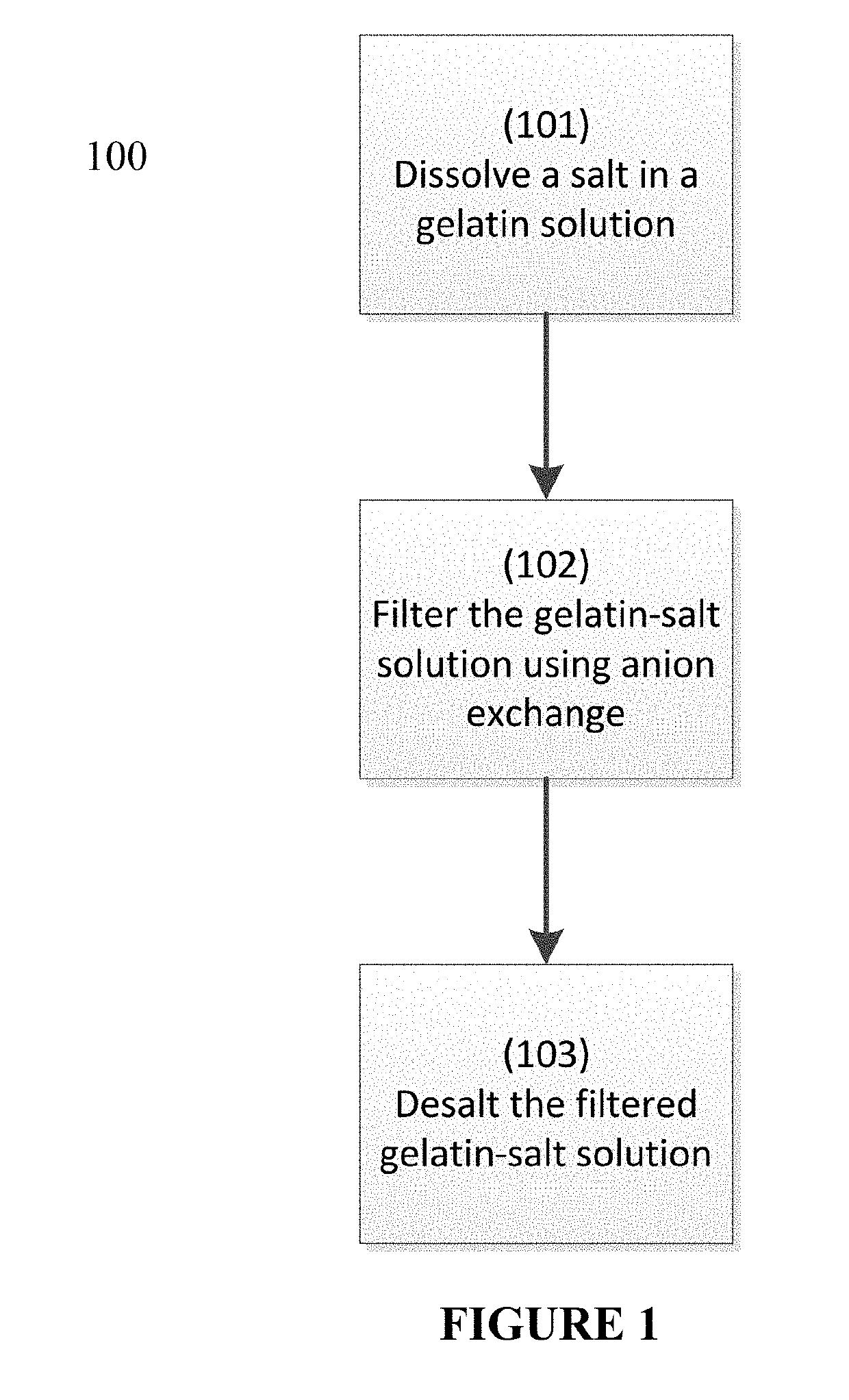Process to reduce endotoxin in gelatin
a technology of endotoxin and gelatin, which is applied in the direction of capsule delivery, microcapsules, ion-exchangers, etc., can solve the problems of endotoxins that can negatively or positively mask the benefit of a given adjuvant, and achieve the effect of low endotoxin content and improved immune respons
- Summary
- Abstract
- Description
- Claims
- Application Information
AI Technical Summary
Benefits of technology
Problems solved by technology
Method used
Image
Examples
example 1
[0068]An amount of fish gelatin containing approximately 7000 EU / g of gelatin was added to an amount of purified water and fully dissolved (with the aid of heating to approximately 60° C. to facilitate the gelatin to dissolve) to give rise to a 10% w / w fish gelatin solution. The solution was then cooled to room temperature and a reference sample was taken for conductivity measurement. Next, an amount of sodium chloride (“NaCl”) was added to the gelatin solution to give a NaCl concentration of 150 mM in the gelatin-NaCl solution. The conductivity of the gelatin-NaCl solution was then measured.
[0069]Before the endotoxin removal, the anion exchange device (Sartobind Q Single Sep mini—7 mL filter) was prepped. Pre-use preparation of the anion exchange device and associated tubing was carried out as per the pre-treatment procedure. A 1M sodium hydroxide (“NaOH”) solution was used to clean and sanitize the system followed by flushing the system with a 1M NaCl solution to remove the NaOH s...
example 2
[0073]An amount of fish gelatin containing approximately 14,600 EU / g of gelatin was added to an amount of purified water and fully dissolved (with the aid of heating to approximately 60° C. to facilitate the gelatin to dissolve) to give rise to a 12% w / w fish gelatin solution. The solution was then cooled to room temperature and a reference sample was taken for conductivity measurement. Next, an amount of sodium chloride (“NaCl”) was added to the gelatin solution to give an NaCl concentration of 150 mM in the gelatin-NaCl solution. The conductivity of the gelatin-NaCl solution was then measured.
[0074]Before the endotoxin removal, the anion exchange device (Sartobind Q 75 mL capsule) was prepped. Pre-use preparation of the anion exchange device and associated tubing was carried out as per the pre-treatment procedure. A 1M sodium hydroxide (“NaOH”) solution was used to clean and sanitize the system followed by flushing the system with a 1M NaCl solution to remove the NaOH solution. Th...
example 3
[0078]An amount of fish gelatin containing approximately 14,600 EU / g of gelatin was added to an amount of purified water and fully dissolved (with the aid of heating to approximately 60° C. to facilitate the gelatin to dissolve) to give rise to a 12% w / w fish gelatin solution. The solution was then cooled to room temperature and a reference sample was taken for conductivity measurement. Next, an amount of sodium chloride (“NaCl”) was added to the gelatin solution to give an NaCl concentration of 150 mM in the gelatin-NaCl solution. The conductivity of the gelatin-NaCl solution was then measured.
[0079]Before the endotoxin removal, the anion exchange device (Sartobind Q 75 mL capsule) was prepped. Pre-use preparation of the anion exchange device and associated tubing was carried out as per the pre-treatment procedure. A 1M sodium hydroxide (“NaOH”) solution was used to clean and sanitize the system followed by flushing the system with a 1M NaCl solution to remove the NaOH solution. Th...
PUM
| Property | Measurement | Unit |
|---|---|---|
| bed volume | aaaaa | aaaaa |
| bed volume | aaaaa | aaaaa |
| bed volume | aaaaa | aaaaa |
Abstract
Description
Claims
Application Information
 Login to View More
Login to View More - R&D
- Intellectual Property
- Life Sciences
- Materials
- Tech Scout
- Unparalleled Data Quality
- Higher Quality Content
- 60% Fewer Hallucinations
Browse by: Latest US Patents, China's latest patents, Technical Efficacy Thesaurus, Application Domain, Technology Topic, Popular Technical Reports.
© 2025 PatSnap. All rights reserved.Legal|Privacy policy|Modern Slavery Act Transparency Statement|Sitemap|About US| Contact US: help@patsnap.com



